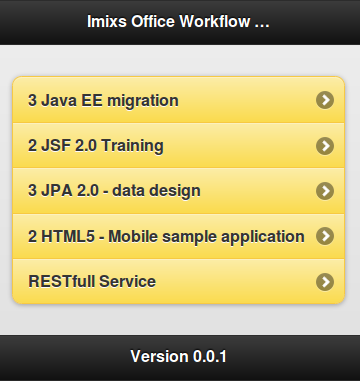Imixs Workflow provides a workflow engine to implement human workflows. Human worflows are used in business applications when a business process is performed by different users. A ticket-system is a typical example for a workflow management system. Customers create a new ticket and the workflow system forwards the the ticket to a technical team to solve the ticket. After a member of the technical team has accepted and solved the ticket the workflow management system forwards the ticket to a quality manager to verify the solution. Finally the solution will be automatically forwarded to the customer. This is a simple example of human workflow inside a business application.
Imixs Workflow provides all the functionality to manage this kind of a business process. You can design the process with an eclipse based modeler to configure things like email notifications, security, dispatching and the process documentation.
The flowing tutorial shows how to run the Imixs Workflow engine in a Java EE 6 business application.
RUNNING IMIXS WORKFLOW IN A WEB MODULE
As the latest version 3.0.0 of Imixs Workflow supports the lightweight EJB model you can run the Imixs Workflow either in a application server like Glassfish or in a Java EE 6 web-container.
The Imixs Workflow engine is independent from a web framework but we recommend to use Java Sever Faces as JSF becomes the standard framework for Java EE web applications.
When you have started developing a new web application you can add the libraries of the Imixs Workflow engine directly into the /lib folder of your web module
/
+- lib/
| |- imixs-workflow-core.jar
| |- imixs-workflow-engine.jar
| |- imixs-workflow-faces.jar
| |- imixs-workflow-jax-rs.jar
If you are using Maven (which is recommended) you can simply add the following dependency into your pom.xml.
<!-- Imixs Workflow -->
<dependency>
<groupId>org.imixs.workflow</groupId>
<artifactId>imixs-workflow-engine</artifactId>
<type>jar</type>
<version>3.0.0-SNAPSHOT</version>
</dependency>
<dependency>
<groupId>org.imixs.workflow</groupId>
<artifactId>imixs-workflow-jax-rs</artifactId>
<type>jar</type>
<version>3.0.0-SNAPSHOT</version>
</dependency>
<dependency>
<groupId>org.imixs.workflow</groupId>
<artifactId>imixs-workflow-faces</artifactId>
<type>jar</type>
<version>3.0.0-SNAPSHOT</version>
</dependency>
Next you need to add a persistence.xml file into your web module. The persistence.xml file defines how the workitems managed by the Imixs Workflow Engine will be persisted into a database.
Add a additional file named persistence.xml into your web module :
/
+- WEB-INF/classes/META-INF/
| |- persistence.xml
The persistence.xml describes the location of you database. The following example shows a typical configuration using the Eclipselink driver provided by most JEE Application servers.
<?xml version="1.0" encoding="UTF-8"?>
<persistence version="1.0" xmlns="http://java.sun.com/xml/ns/persistence">
<persistence-unit name="org.imixs.workflow.jee.jpa" transaction-type="JTA">
<provider>org.eclipse.persistence.jpa.PersistenceProvider</provider>
<jta-data-source>jdbc/workflow-db</jta-data-source>
<jar-file>lib/imixs-workflow-engine-3.0.0-SNAPSHOT.jar</jar-file>
<properties>
<property name="eclipselink.ddl-generation"
value="create-tables" />
<property name="eclipselink.logging.level" value="INFO"/>
</properties>
</persistence-unit>
</persistence>
The jta-data-source with the name “jdbc/workflow-db” describes the jdbc connection used to store the imixs workflow data. You can configure the database resource directly in your application server. For more details about how to setup a database connection read ‘Installation and setup the Glassfish Application Server‘.
ADDING SECURITY CONFIGURATION AND WEB SERVICE
Now as the Imixs Workflow engine is part of your web module you need to configure security roles expected by the Imixs Workflow.
To map the Imixs Workflow roles into your web application use the security-role-ref in the web.xml.
<login-config>
<auth-method>BASIC</auth-method>
<realm-name>imixsrealm</realm-name>
</login-config>
<security-constraint>
<web-resource-collection>
<web-resource-name>restricted</web-resource-name>
<url-pattern>/pages/*</url-pattern>
<url-pattern>/rest/*</url-pattern>
<http-method>GET</http-method>
<http-method>POST</http-method>
</web-resource-collection>
<auth-constraint>
<role-name>org.imixs.ACCESSLEVEL.READERACCESS
</role-name>
<role-name>org.imixs.ACCESSLEVEL.AUTHORACCESS
</role-name>
<role-name>org.imixs.ACCESSLEVEL.EDITORACCESS
</role-name>
<role-name>org.imixs.ACCESSLEVEL.MANAGERACCESS
</role-name>
</auth-constraint>
</security-constraint>
<security-constraint>
<web-resource-collection>
<web-resource-name>restricted</web-resource-name>
<url-pattern>/RestService/*</url-pattern>
<http-method>GET</http-method>
<http-method>POST</http-method>
<http-method>PUT</http-method>
</web-resource-collection>
<auth-constraint>
<role-name>org.imixs.ACCESSLEVEL.MANAGERACCESS
</role-name>
</auth-constraint>
</security-constraint>
<security-role>
<role-name>org.imixs.ACCESSLEVEL.NOACCESS
</role-name>
</security-role>
<security-role>
<role-name>org.imixs.ACCESSLEVEL.READERACCESS
</role-name>
</security-role>
<security-role>
<role-name>org.imixs.ACCESSLEVEL.AUTHORACCESS
</role-name>
</security-role>
<security-role>
<role-name>org.imixs.ACCESSLEVEL.EDITORACCESS
</role-name>
</security-role>
<security-role>
<role-name>org.imixs.ACCESSLEVEL.MANAGERACCESS
</role-name>
</security-role>
To map the roles to your user management and security groups for glassfish servers add the sun-web.xml file into your /WEB-INF folder:
<?xml version="1.0" encoding="UTF-8"?>
<!DOCTYPE sun-web-app PUBLIC "-//Sun Microsystems, Inc.//DTD Application Server 9.0 Servlet 2.5//EN" "http://www.sun.com/software/appserver/dtds/sun-web-app_2_5-0.dtd">
<sun-web-app error-url="">
<context-root>/workflow</context-root>
<security-role-mapping>
<role-name>org.imixs.ACCESSLEVEL.NOACCESS</role-name>
<group-name>Noaccess</group-name>
<group-name>IMIXS-WORKFLOW-Noaccess</group-name>
</security-role-mapping>
<security-role-mapping>
<role-name>org.imixs.ACCESSLEVEL.READERACCESS</role-name>
<group-name>Reader</group-name>
<group-name>IMIXS-WORKFLOW-Reader</group-name>
</security-role-mapping>
<security-role-mapping>
<role-name>org.imixs.ACCESSLEVEL.AUTHORACCESS</role-name>
<group-name>Author</group-name>
<group-name>IMIXS-WORKFLOW-Author</group-name>
</security-role-mapping>
<security-role-mapping>
<role-name>org.imixs.ACCESSLEVEL.EDITORACCESS</role-name>
<group-name>Editor</group-name>
<group-name>IMIXS-WORKFLOW-Editor</group-name>
</security-role-mapping>
<security-role-mapping>
<role-name>org.imixs.ACCESSLEVEL.MANAGERACCESS</role-name>
<group-name>Manager</group-name>
<group-name>IMIXS-WORKFLOW-Manager</group-name>
</security-role-mapping>
</sun-web-app>
Finally you can add the Imxis RESTfull Service interface to provide a business modeler directly from your eclipse ide using the Imixs Workflow modeler plugin. With the Imixs RESTfull Service you can access the Imixs Workflow engine from external clients.
To add the Rest Service add the following servlet description into your web.xml file:
<!-- Imixs Rest Service -->
<servlet>
<servlet-name>Jersey Web Application</servlet-name>
<servlet-class>com.sun.jersey.spi.container.servlet.ServletContainer</servlet-class>
<init-param>
<param-name>com.sun.jersey.config.property.packages</param-name>
<param-value>org.imixs.workflow.jaxrs</param-value>
</init-param>
<load-on-startup>1</load-on-startup>
</servlet>
<servlet-mapping>
<servlet-name>Jersey Web Application</servlet-name>
<url-pattern>/rest/*</url-pattern>
</servlet-mapping>
Thats it.
To build a workflow model and synchronize it with your workflow application see the Installation and setup guide of the Imixs Workflow Modeler.
IMIXS WORKFLOW AND JSF
Now the Imixs Workflow engine is part of your web application. To access the Imixs Workflow engine the imxis-faces module provides a BackingBean. You can add this BackingBean simply by extending the faces-config.xml file located in the /WEB-INF folder of you web project.
<managed-bean>
<managed-bean-name>workflowMB</managed-bean-name>
<managed-bean-class>org.imixs.workflow.jee.jsf.util.SimpleWorkflowController</managed-bean-class>
<managed-bean-scope>session</managed-bean-scope>
</managed-bean>
To create a new workitem you call the method doCreateWorkitem. This method expects an existing process-id form your previous diefined workflow model. This is an example where you create a new instance of a business process with the processID=100
<h:commandButton
value="create new...."
actionListener="#{workflowMB.doCreateWorkitem}"
action="show_workitem">
<f:param name="id"
value="100" />
</h:commandButton>
The workflowMB allows you to bind an input value to an arbitrary property name. See the following example were an inputText value is bound to the item property ‘txtSubject’.
<h:inputText required="true"
value="#{workflowMB.workitem.item['txtSubject']}" id="subject_id">
</h:inputText>
The workflow controller will automatically manage the property “txtSubject” and store the input values into the database.
Finally you can process a workitem through the Imixs Workflow by simply calling the method doProcess :
<h:commandButton action="show_workitem"
actionListener="#{workflowMB.doProcessWorkitem}"
value="submit">
<f:param name="id" value="10" />
</h:commandButton>
You can download the full sample application from the Imixs Download center. This sample application can be used as a template to start you own business workflow project.
You will find more examples and a full installation guide at: http://www.imixs.org/jee/install.html

